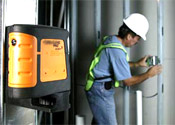Multiline Laser Levels
Johnson Line Laser Levels are the solution when you want to mark a level plane across a wall. Our straight line laser levels project horizontal and vertical laser lines at 90 degrees to each other. With self leveling laser level technology, all Johnson line laser levels will automatically project a level laser beam, even when situated on uneven ground. If the line laser level has tilted beyond the point where self leveling can occur, visual and audible alarms will sound. With the use of a laser detector, Johnson Line Laser Levels can even be used outside. Common line laser level applications are installation of drop ceilings, drywall, sprinklers, wallpaper, light fixtures, windows and MUCH more. Johnson Level also has specialty straight line laser level products, like our Tiling and Flooring Laser Level, and our Hot Shot Laser Mouse, which can adhere to any surface while projecting a level laser line!
Today, the three most common types of laser levels are Rotary Laser Levels, Laser Line Levels (or Line Generators) and Dot Laser Levels (or Multi-Point Lasers) This article focuses on the technical specifications of Laser Line Levels.
Laser Line Level

laserLineLevel-Electricians
electrician placing a wall switch with Johnson Self-Leveling Ultra-Bright Cross-Line Laser Level Model: 40-6625
Line Laser Levels project a beam of light typically 180-degrees both horizontally and vertically, allowing the user to establish a horizontal or vertical plane. Some Laser Line Levels can also project a beam of light 360-degrees. In fact, this beam of light is really a single dot of light that when projected through a beam spreading prism, projects a 180 or 360-degree chalk line. When working indoors, the Line Laser Level is useful for anything needing horizontal leveling around a room or a vertical leveling from floor to ceiling.
The beam of light is created by what is called a diode, which in this case is simply a semiconductor which produces light when current passes through it. We see diodes everyday on our CD players, computers and television remote controls.
How To Use a Laser Line Level
- Set up the laser line level on as flat (level) of a surface as possible. A saw horse or even a bucket is good. Any sort of tripod is usually best.
- Make sure the level is level. Laser line levels are leveled in two ways.
- Manual leveling: The operator make the laser level by adjusting the laser to bubble vials built into the laser. A. Accuracy is going to depend on the quality of the level vial and the operator’s eye. Although accuracy can be 1/2″ per 20 feet and setup is longer due to the manual leveling, it is the least expensive laser available.B. Self-Leveling: The laser levels itself through a pendulum and magnets. Accuracy is typically 1/8” per 50 feet, which is better than manual.
- Begin measuring and marking. Once you have a level line, use it for reference. Make marks on the laser line and then measure down or up from there. Make all necessary marks before turning the laser level off.
- Turn off the laser. You’re ready to go!


